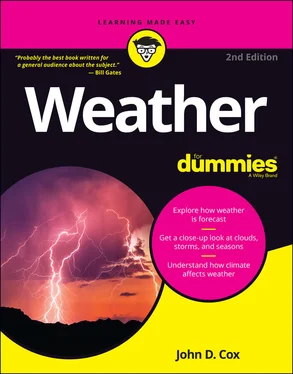1 ...7 8 9 11 12 13 ...18 Marine forecasts let boaters know what kinds of winds to expect, whether the sea will be calm, and, if not, the height and direction of rolling swells. Small craft warnings for strong winds or fog conditions and other hazard advisories are issued in areas along the seacoasts and the shores of large lakes.
National Weather Service forecasters work closely with hydrologists, who are water experts. A weather forecaster estimates how much rainfall is likely from a particular storm, and the hydrologist figures out how much that precipitation will cause certain rivers and streams to rise.
Forecasters also keep operators of federal and state dams informed as major storm systems approach large river systems. Sometimes a dam is good for saving water when there is too little, and sometimes a dam is good for saving a downstream city where there is too much. If they know a big storm is on the way, dam operators sometimes release more water from their spillways to make more room in their reservoirs to hold floodwaters.
Regional River Forecast Centers are spread around 13 locations in the United States. These centers are where National Weather Service forecasters prepare river and flood forecasts and warnings for approximately 3,000 communities around the country.
A corps of specially-trained weather specialists keep their eyes on the skies above national forests and other regions of their nation where wildfires are a major threat. These specialists are experts on the effect that weather has on the risk of a fire starting. They keep an eye on the dryness of the soil and vegetation, on temperatures, and on winds and humidity.
They also have special knowledge about local conditions, such as the mountains and canyons, and how they affect winds, which are crucial to how fast and how far a fire burns. During some large fires in the western United States, a fire weather specialist is sometimes dispatched to the scene to keep firefighters informed of changing conditions. Chapter 13has more detail about fire weather and the impact of our changing climate on wildfires.
You hear these words all the time on your local forecast: highs and lows and temperatures and pressures and wind chills and humidities and chances of showers and wind speeds and directions. But just how slight or how likely is a chance of showers? What exactly are you being told?
When forecasters see rain or snow on the way, they have some decisions to make about how to describe the precipitation they expect. They need to think about how likely it is, how long it will last, and how intense it will be. What is the probability, or chance, that it will rain? Will it rain “’til the cows come home” or only briefly? When it rains, will it “come down like cats and dogs” or merely sprinkle?
Sometimes when people hear the word rain in a forecast, that’s the only word that catches their attention. They make the mistake of assuming that it is absolutely certain that rain will fall on their head sometime during the day. And if it doesn’t, well, “Wrong again, the weatherperson said it would rain.” More likely, the forecaster used a few key words that didn’t make the same impression as “ rain in the forecast.”
The National Weather Service has issued guidelines for expressing the likelihood of precipitation in hopes that certain word usages would become standard among forecasters. It hasn’t worked out very well.
For one thing, the terms the agency uses are easy to misunderstand. It leans heavily on using something called probability of precipitation, which sounds fairly simple when you hear it. But it can mean one thing for one person and something else for another and might even be used to express different things under different weather circumstances.
 Technically, probability of precipitation is the chance, expressed as a percentage, that a measurable amount of rain — .01 of an inch or more — will fall someplace in the forecast area in the next 12 hours. It is a combination of two figures — the likelihood of precipitation in the area and the percentage of the area that is likely to get it. This doesn’t tell you as much as you might think. If there is a 50 percent chance that rain will develop anywhere in the forecast area, and 40 percent of the area is expected to get rain, this translates into a 20 percent chance of rain.
Technically, probability of precipitation is the chance, expressed as a percentage, that a measurable amount of rain — .01 of an inch or more — will fall someplace in the forecast area in the next 12 hours. It is a combination of two figures — the likelihood of precipitation in the area and the percentage of the area that is likely to get it. This doesn’t tell you as much as you might think. If there is a 50 percent chance that rain will develop anywhere in the forecast area, and 40 percent of the area is expected to get rain, this translates into a 20 percent chance of rain.
A 70 percent chance of rain doesn’t tell you that there is a 70 percent chance of rain everywhere in the forecast area, for example, and it doesn’t tell you that rain will fall on 70 percent of the area. It’s easy to think that a 70 percent chance of rain means a pretty hefty rainfall is likely, and a 20 percent chance means that only a little rainfall is on the way. But that would be wrong, too. Probability of precipitation doesn’t tell you anything about how long it is going to rain or how much it is likely to rain.
It’s easy to see why many television meteorologists put a different spin on the forecast, finding other ways to tell viewers what to expect. Other meteorologists at private forecasting firms such as AccuWeather Inc. employ a more user-friendly “public communications meteorology” that is intended to better describe how the day’s weather is likely to go than the National Weather Service’s way of saying things.
The National Weather Service forecast might say something like this: “Partly sunny today with showers and thunderstorms likely in the afternoon. Probability of precipitation is 70 percent.”
AccuWeather’s version of such a forecast might go something like this: “Sunshine this morning, clouds will billow up during the afternoon, bringing much of the area a brief downpour between 5 and 8 p.m.”
Often, you will hear forecasters use a variety of key words to give more meaning to the probability statistics that the computer models put out. These words can describe the likelihood of rain in other ways. They might tell you how certain the chances are of rain, for example, or they could tell you how much area the rain is likely to cover.
A slight chance of rain, for instance, generally means that the probability of rain is 20 percent or less. Expressed another way, a slight chance of rain can be described as scattered showers. At least, that’s what the National Weather Service has in mind.
When a forecaster says there is a 30 percent chance of showers, it is worth keeping in mind the other side of the coin: There is a 70 percent chance that it won’t rain! When a forecaster predicts scattered showers, it doesn’t mean it is going to scatter showers on you. (So count yourself lucky and give your forecaster a break!)
Another set of four key words often is used to describe the duration of the rain that forecasters expect: brief, occasional, intermittent, frequent.
A weather forecaster also can use key words to describe the intensity of the rain or snow to expect. Nobody does it exactly the same way, but here are how some of the key words are commonly used for describing rainfall intensities:
Very light, when a trace, or less than .01 of an inch is expected
Light , from .01 to .10 inch per hour
Moderate , from .10 to .30 inch per hour
Heavy, for anything above .30 inch per hour
Daytime maximum temperatures and nighttime minimums that a forecaster expects are often expressed as ranges. If the forecast covers a wide area, the highs and lows are not going to be the same in one place as in another. Besides, few forecasters would pretend that they can predict the exact degree of high and low temperatures.
Читать дальше

 Technically, probability of precipitation is the chance, expressed as a percentage, that a measurable amount of rain — .01 of an inch or more — will fall someplace in the forecast area in the next 12 hours. It is a combination of two figures — the likelihood of precipitation in the area and the percentage of the area that is likely to get it. This doesn’t tell you as much as you might think. If there is a 50 percent chance that rain will develop anywhere in the forecast area, and 40 percent of the area is expected to get rain, this translates into a 20 percent chance of rain.
Technically, probability of precipitation is the chance, expressed as a percentage, that a measurable amount of rain — .01 of an inch or more — will fall someplace in the forecast area in the next 12 hours. It is a combination of two figures — the likelihood of precipitation in the area and the percentage of the area that is likely to get it. This doesn’t tell you as much as you might think. If there is a 50 percent chance that rain will develop anywhere in the forecast area, and 40 percent of the area is expected to get rain, this translates into a 20 percent chance of rain.










